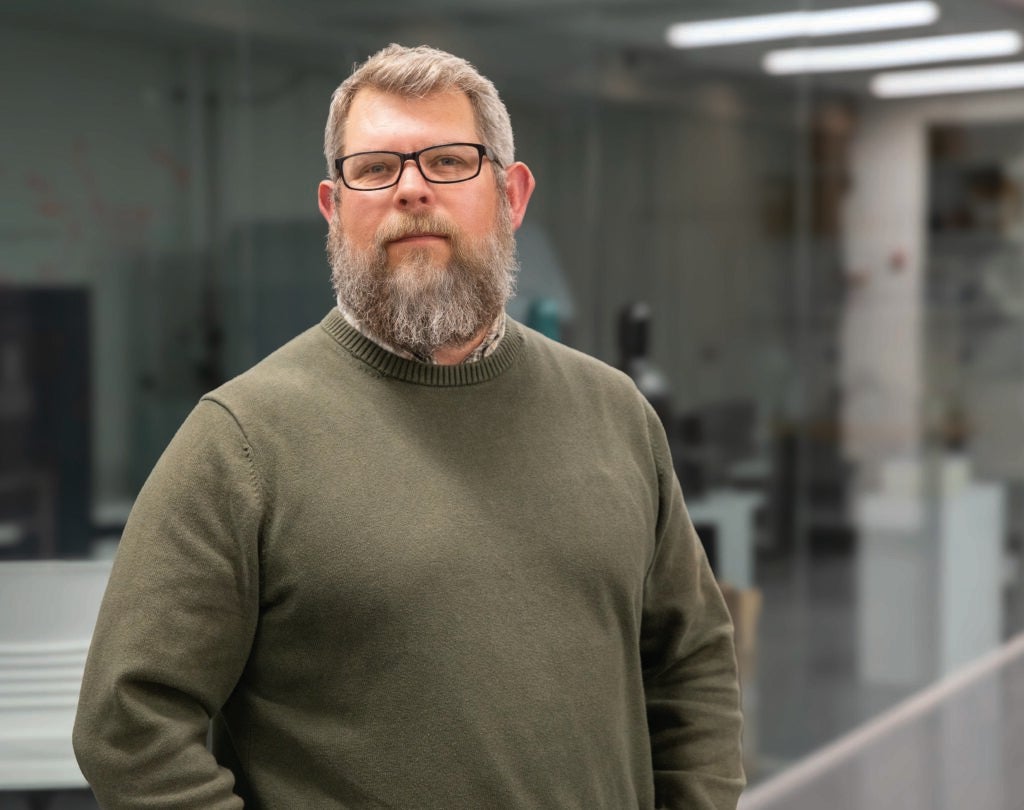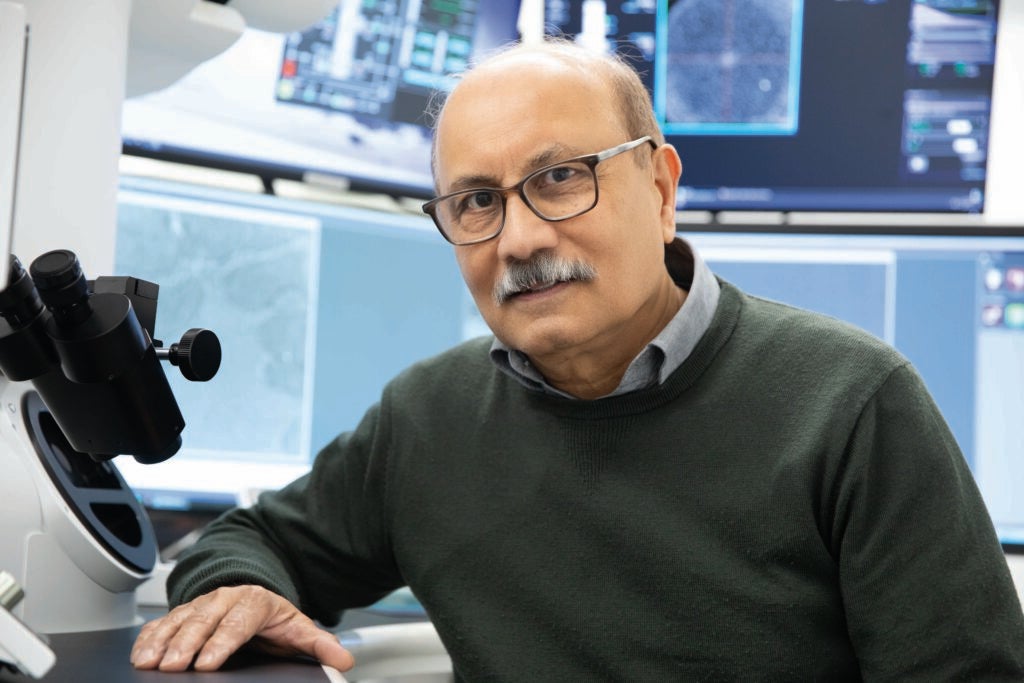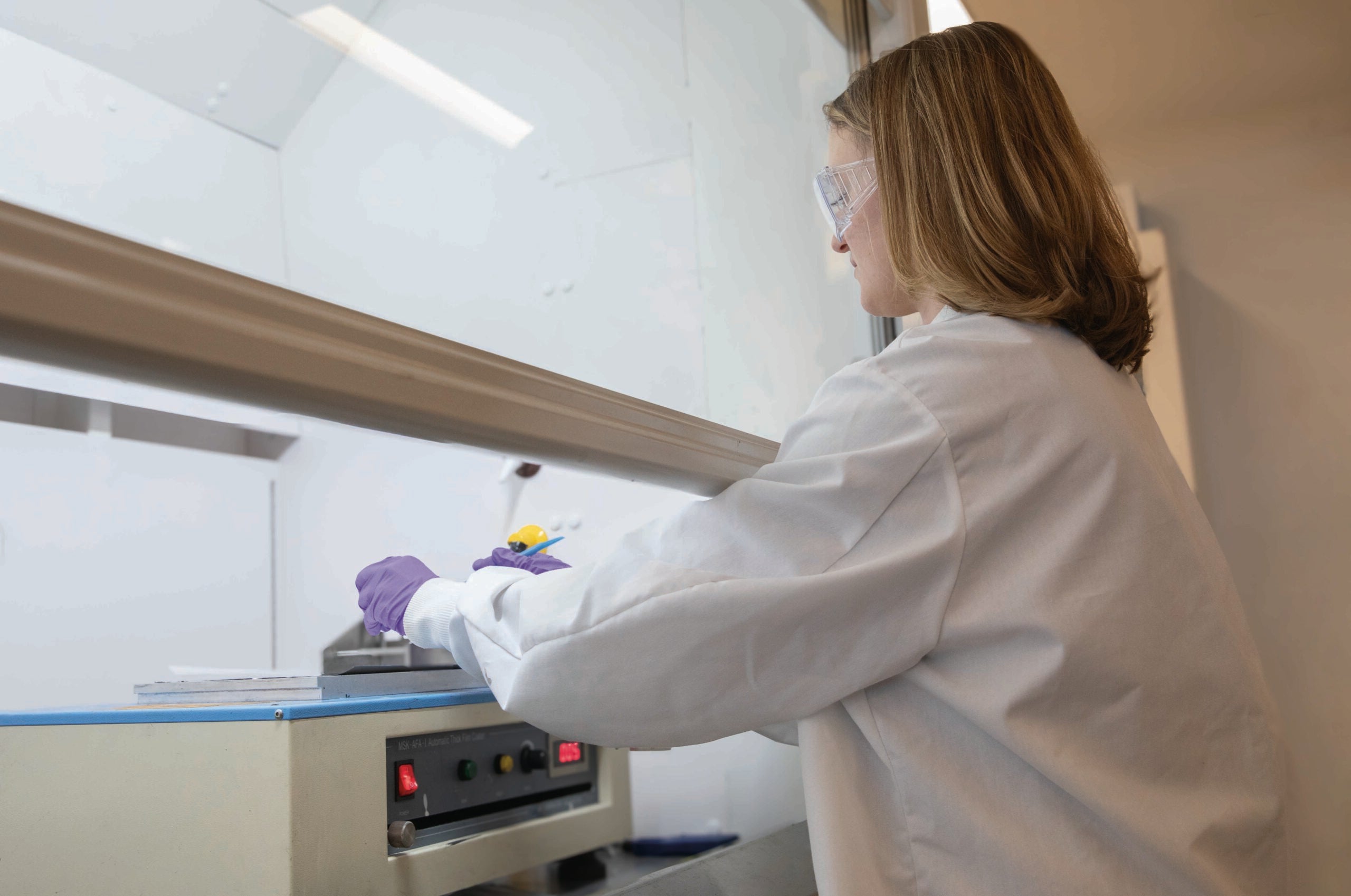At URI, nanotechnology researchers are shrinking science to expand possibility.
By Michael Blanding
Something amazing happens when you shrink matter down to size. Materials that behave one way in the visible realm can act completely differently as invisible nanoparticles, measuring between one and 100 nanometers—a fraction of the width of a human hair.
“When you shrink down to that length, the size is actually similar to the wavelength of light,” says University of Rhode Island (URI) Professor Geoffrey Bothun, chair of the Department of Chemical, Biomolecular, and Materials Engineering. “Most of the atoms in the matter that are usually tucked away are now on the surface, and because of the abundance of those surface atoms, they now behave very differently.”

Chair, Department of Chemical, Biomolecular, and Materials Engineering
Nanoparticles’ unique quirks have made them commercially useful in a broad range of consumer products—including clothing, sunscreen, solar panels, and electronics—as well as scientifically valuable in solving a variety of engineering challenges.
At URI, a trio of researchers is pushing the frontiers of the nanoscale, developing particle-based solutions for medicine, oceanography, and environmental monitoring, among other applications. Supported by grants from the National Science Foundation (NSF) for research and equipment, their research works to turn invisible particles into tangible societal benefits.
As Distinguished Engineering Professor Arijit Bose says, “It’s the small things that have a big impact.”
Surface Matters
Bose first came to URI in 1982, launching his research career with an NSF initiation grant to study how liquids spread across surfaces. About a decade in, he shifted focus to nanoparticles.

“Really small particles with very interesting properties,” says Bose. “For example, the color of particles changes with particle size when they become really small”
Bothun, who arrived at URI in 2006, had done his own research on how nanoparticles interact with cell membranes as a postdoc at A&T State University in North Carolina, investigating the toxicity of nanoparticles in the environment. He collaborated with Bose to experiment with various nanoparticles of gold, silver, and iron oxide, which could be manipulated inside the body to treat tumors and other problem areas.
In addition to funding the research, the NSF was crucial in providing support for several pieces of high-priced equipment without which the work on invisible particles would be impossible, including a transmission electron microscope and a dynamic light scattering instrument that allows a researcher to determine the sizes of nanoparticles in a solution. In 2018, the department replaced the original microscope with a new state-of-the-art scanning transmission electron microscope now housed in the Fascitelli Center for Advanced Engineering.
“These are core facilities,” says Bose. “They’re open to anybody in the University to do research.”
Eating Oil and Predicting Algae Blooms
In 2010, when oil spewed into the Gulf of Mexico after the Deepwater Horizon explosion, Bose realized that the same properties of nanoparticles that allowed them to self-assemble also could be used to facilitate oil cleanup. When oil gushes out underwater, it rises to the surface where it sits as a thick film upon the waves. Eventually naturally occurring bacteria will break it down, but that process can take a long time due to the limited surface area with which bacteria have to work.
Injecting carbon black particles—tiny ink-like nanoparticles with both water-loving and oil-loving surfaces—can cause them to bind to the oil to create tiny droplets instead.
“You expose a lot more surface area,” says Bose, which speeds the breakdown of the spill, and unlike the soap that the Coast Guard sometimes injects for the same purpose, the particles are non-toxic.
Bothun also has turned his attention underwater, developing nanosensors that could transform how researchers track pollution in Narragansett Bay. The research began when Bothun became primary investigator for a $20 million NSF grant made to Rhode Island under the Established Program to Stimulate Competitive Research (EPSCoR), which works to bolster regional science infrastructure. The sensors start with a wafer just two millimeters across—like a camera chip—embedded with forests of gold nanopillars.
“When a molecule gets between these pillars,” he says, “it experiences an electromagnetic field. You shine light on it, it vibrates the molecules, and you can detect that vibration,” to identify what it is.
Bothun is now exploring ways to embed such sensors into buoys or drones to create a real-time chemical footprint of the bay, including monitoring changes in nitrogen and phosphorus levels that could signal the start of an algae bloom.
“Usually, they start before you know it, and have tremendous impact on fisheries,” Bothun says. “We’re trying to find a way to predict that in advance.”
Nanoscrubbing Biofilms
The Rhode Island Consortium for Nanoscience and Nanotechnology (RIN2) was established as a collaboration between URI and Brown University in 2010 to provide access to advanced equipment and training researchers at universities and private companies across the state. From 2018 to 2022, Irene Andreu was the director of operations of RIN2 and continues as its Scientific Director. Andreu, a researcher originally from Spain, previously studied how to use magnetic nanoparticles inside the body to treat cancer as a postdoc at Simon Fraser University in Canada.
Similarly to Bose and Bothun’s techniques, Andreu experimented with iron oxide particles injected into the body and directed the particles with magnets to a cancerous tumor. Once there, a magnetic field spins the particles to generate heat.

Assistant Professor, Chemical, Biomolecular and Materials Engineering
“Just by raising the temperature, you can selectively damage cancer cells without harming healthy tissue,” she explains.
Elsewhere at RIN2, Andreu maintained equipment and trained students and other researchers on its use, including an ongoing project to characterize microplastics samples from rivers and ponds across the state.
In 2022, Assistant Professor Andreu joined the URI Department of Chemical, Biomolecular and Materials Engineering using magnetic nanoparticles for a different purpose: scrubbing biofilms from underwater surfaces.
“Anything that goes underwater will get fouled,” she says. “Eventually building up algae and barnacles that can damage boats and equipment. If we can remove the initial bacteria, it will prevent the formation of larger microorganisms that generate most of the problems.”
The technique Andreu is developing, funded in 2023 by the NSF Engineering Research Initiation program, uses rotating magnets to create a magnetic field, applying force at a distance to magnetic nanoparticles that are custom designed to bind to bacteria, physically pulling invasive hitchhikers off the surface. The approach could save millions of dollars on maintenance costs and potentially be applied to medical and food processing applications as well.
Discovery in All Directions
All three researchers stress the role of the NSF in their work—not just in funding equipment but allows the kind of open-ended exploration that keeps innovation alive. Bothun has recently returned to some of his early membrane work in an NSF-funded collaboration with Brown University researchers to dramatically improve imaging of the brain using nanoparticles injected into brain fluid, a process known as magnetic particle imaging (MPI).
It’s the kind of flexibility that NSF funding allows, enabling researchers to pivot from investigating the vastness of the ocean to the most delicate cells inside the human body.
“The NSF is a great federal agency because they’re open to exploration—when new discoveries take you in a different direction, you are able to pursue that,” Bothun says. “There’s still so much to discover in the field of nanotechnology that can solve problems and improve lives.”
“It’s the small things that have a big impact.”Distinguished Engineering Professor Arijit Bose


